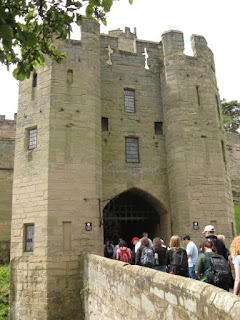I booked myself a tour with London Walks, arrived at Paddington Station ready to go at 8:15... and then sat around for half an hour. Doh. In the meantime, I took photos.
 Tadaa! Then, once we were off:
Tadaa! Then, once we were off: The glorious British weather could be seen. (I've only just noticed this picture includes swans: that gives it an air of... interest, almost? Wow. :P) Two hours on the train followed, in which I lost myself in Clint Black and tried to forget how much the darned trip would cost.
The glorious British weather could be seen. (I've only just noticed this picture includes swans: that gives it an air of... interest, almost? Wow. :P) Two hours on the train followed, in which I lost myself in Clint Black and tried to forget how much the darned trip would cost. When we arrived in Warwick, our guide took us on a half-hour tour of the town. It was filled with iconic English buildings, black-on-white with timber framing and those gorgeous flower pots (why don't we have them here? Everyone else in Europe has caught on). Also included was an authentic Victorian postbox, a stone archway that survived the devastating fire of 1694, and an inn called 'the Crown and Castle'.
When we arrived in Warwick, our guide took us on a half-hour tour of the town. It was filled with iconic English buildings, black-on-white with timber framing and those gorgeous flower pots (why don't we have them here? Everyone else in Europe has caught on). Also included was an authentic Victorian postbox, a stone archway that survived the devastating fire of 1694, and an inn called 'the Crown and Castle'. St Mary's Church, which had a new nave and tower added in the early 1700's and was looked over by the oh-so-famous Sir Christopher Wren.
St Mary's Church, which had a new nave and tower added in the early 1700's and was looked over by the oh-so-famous Sir Christopher Wren.
 A very American view, I thought. But then, they had to get it from somewhere. :P
A very American view, I thought. But then, they had to get it from somewhere. :P
 Inside the Church, looking down one of the side isles at the great organ.
Inside the Church, looking down one of the side isles at the great organ.




 Ah! Now this was wonderful. Here, we're looking at the tomb of Robert Dudley, Earl of Leicester and incredibly influential favourite of Elizabeth I. Dudley himself! :D I know it may mean nothing to most people, but for at least four months in History last year we were bombarded with the loves, lives and fates of the famous of the 16th century - and he was most definitely included.
Ah! Now this was wonderful. Here, we're looking at the tomb of Robert Dudley, Earl of Leicester and incredibly influential favourite of Elizabeth I. Dudley himself! :D I know it may mean nothing to most people, but for at least four months in History last year we were bombarded with the loves, lives and fates of the famous of the 16th century - and he was most definitely included. Another gorgeous roof. Such consistent splendour has spoiled me for weatherboards, I think.
Another gorgeous roof. Such consistent splendour has spoiled me for weatherboards, I think. The tomb of.... Wait, I know this - or Google does. Richard Beauchamp, according to the St Mary's website "the Earl of Warwick and one of the richest and most powerful people in the history of our country". Wikipedia: "Richard de Beauchamp, 13th Earl of Warwick (23 January 1382 – 30 April 1439) was an English medieval nobleman and military commander." During his life, he fought the last native Prince of Wales, Owain Glyndwr; taught a young Henry VI; went on a pilgrimage to Holy Land and was named a Knight of the Garter.
The tomb of.... Wait, I know this - or Google does. Richard Beauchamp, according to the St Mary's website "the Earl of Warwick and one of the richest and most powerful people in the history of our country". Wikipedia: "Richard de Beauchamp, 13th Earl of Warwick (23 January 1382 – 30 April 1439) was an English medieval nobleman and military commander." During his life, he fought the last native Prince of Wales, Owain Glyndwr; taught a young Henry VI; went on a pilgrimage to Holy Land and was named a Knight of the Garter. Wow. See, now I'm getting post-trip tingles. ^^


 Back outside St Mary's, on the streets of Warwick - and how can you ever get sick of such perfect English names?
Back outside St Mary's, on the streets of Warwick - and how can you ever get sick of such perfect English names? One of the most impressive sites in the town, Lord Leycester Hospital. Google once more (I really should learn this stuff!): the chapel, living quarters, halls and guildhall were built between 1300 and 1450 and contain a stone vase that is more than 2,000 years old.
One of the most impressive sites in the town, Lord Leycester Hospital. Google once more (I really should learn this stuff!): the chapel, living quarters, halls and guildhall were built between 1300 and 1450 and contain a stone vase that is more than 2,000 years old. The best kind of street there is!
The best kind of street there is! Warwick Castle itself. I'll do a list of quick facts, but first: I love the way English is so overflowing with history that you have to condense the story of a building like this - almost 1100 years' worth - into one or two sentences. In NZ, we'd give you that little information only because a century of European colonisation is just so darn boring!
Warwick Castle itself. I'll do a list of quick facts, but first: I love the way English is so overflowing with history that you have to condense the story of a building like this - almost 1100 years' worth - into one or two sentences. In NZ, we'd give you that little information only because a century of European colonisation is just so darn boring!So: Warwick. Argicola's Roman legions built a fort in this area around 79AD - later, the daughter of Saxon King Alfred the Great constructs a fortified town, probably on the same site. In 1068, a wooden motte-and-bailey castle replaces it under the orders of William the Conqueror, and in 1260 it's made stone - only to be beseiged by mangonel and trebuchet in the early 1300's. Afterwards, we have the age of the Earls de Beauchamp and glorious chivalry: feasts, tournaments, the Black Death... Aha! Another interesting fact about Richard: he supervised the trial of joan of Arc. ('Interesting' doesn't even get close, does it?)
Can't be quick: must stop now, or you'll be sifting through pages of waffling about knights, quests, wars and abbeys... Not that you haven't already suffered a bit! ^^
 The stocks.
The stocks.
 Entrance to the Kingmaker Exhibition, about the Earl of Warwick who supported first York and then Lancaster. (Warwick Castle is owned now by Madame Tussaud's, so there were many wax figurines inside and not so much information!)
Entrance to the Kingmaker Exhibition, about the Earl of Warwick who supported first York and then Lancaster. (Warwick Castle is owned now by Madame Tussaud's, so there were many wax figurines inside and not so much information!) The Mound, the oldest part of the castle, built in 1068 on the orders of William the Conqueror.
The Mound, the oldest part of the castle, built in 1068 on the orders of William the Conqueror. Inside the State Rooms.
Inside the State Rooms. *bounces* Look at that painting. That's one of four nearly identical pictures I've been staring at for months in History textbooks: Charles I, in his warlike, 'prince of justice' incarnation. That's Charles I! :D
*bounces* Look at that painting. That's one of four nearly identical pictures I've been staring at for months in History textbooks: Charles I, in his warlike, 'prince of justice' incarnation. That's Charles I! :D Out on the green, the crowds are treated to displays of medieval sword-fighting by two men: a 45-year-old diabetic and a failed Welsh salesman. Very entertaining. ^^
Out on the green, the crowds are treated to displays of medieval sword-fighting by two men: a 45-year-old diabetic and a failed Welsh salesman. Very entertaining. ^^

 The Great Hall. This room has been standing since the 14th century and would originally have been near windowless, with a fire in the centre and the castle's inhabitants sleeping in rows against the walls; later, it hosted a feast for James I (1604-1625) that bankrupted the town of Warwick for 10 years.
The Great Hall. This room has been standing since the 14th century and would originally have been near windowless, with a fire in the centre and the castle's inhabitants sleeping in rows against the walls; later, it hosted a feast for James I (1604-1625) that bankrupted the town of Warwick for 10 years. Just what it says. :) Queen Elizabeth I's handkerchief, c.1575.
Just what it says. :) Queen Elizabeth I's handkerchief, c.1575.
































No comments:
Post a Comment